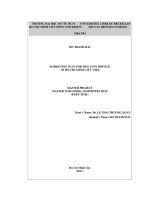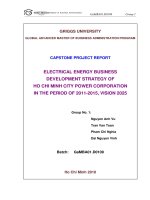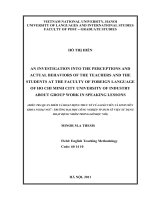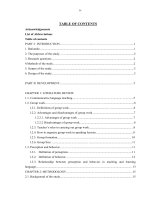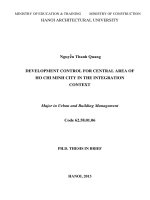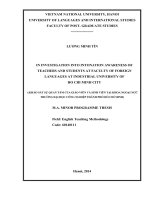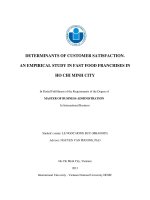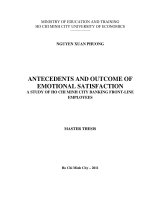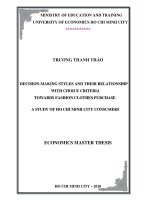Language attitudes of Vietnamese undergraduates towards English: An investigation at school of advanced studies of Ho Chi Minh city Open University
Bạn đang xem bản rút gọn của tài liệu. Xem và tải ngay bản đầy đủ của tài liệu tại đây (440.28 KB, 17 trang )
84 Journal of Science Ho Chi Minh City Open University – VOL. 19 (3) 2016 – October/2016
LANGUAGE ATTITUDES OF VIETNAMESE
UNDERGRADUATES TOWARDS ENGLISH: AN
INVESTIGATION AT SCHOOL OF ADVANCED STUDIES OF
HO CHI MINH CITY OPEN UNIVERSITY
TRINH THAI VAN PHUC
Ho Chi Minh City Open University, Vietnam – Email:
(Received: May 13, 2016; Revised: August 8, 2016; Accepted: October 10, 2016)
ABSTRACT
The investigation reported in this paper is carried out with 444 undergraduates enrolled in the first semester of
academic year 2014-2015, which seeks to examine language attitudes towards English language achievement and
formation of ethnic identity of Vietnamese undergraduates at Ho Chi Minh City Open University (HCMCOU). The
investigation surveys this topic by discussing the study of language attitudes, effects of language attitudes on
language achievement, English in Vietnam and awareness of Vietnamese ethnic identity and issues about the
relationship between language attitudes and language achievement. The questionnaire survey is conducted to
examine students’ language attitudes, which is adapted from Axler et al. (1998) as cited in Liu & Zhao (2011). The
results show that students hold positive attitudes towards English and are extrinsically and intrinsically motivated to
learn English. They show their sense of Vietnamese patriotism in preserving linguistic and cultural identity on
account of nearly 60 per cent of wishing to learn Vietnamese well. Concurrently, they illustrate their appreciation of
English status in light of 40 per cent showing their preference to learn good English first.
Keywords: language attitudes; language achievement and ethnic identity.
1. Introduction
According to Fasold (1984, p. 148),
language attitude is “the attitudes toward
language itself.” Gardner and Smythe (1975)
assert that attitudes are given of a central role
in language learning through their influence
on motivation. The usual interaction between
language attitudes and motivation becomes of
paramount importance in language learning
(Liu, 2009; Dornyei, 2001; Tremblay &
Gardner, 1995; Gardner, 1985; Gardner &
MacIntyre, 1993). This kind of attitudinal/
motivational influence toward a language
might be positive or negative. It probably
leads to successful language learning since
learners will be more attentive, critical and
interested in their study. It is futile to attempt
to support language learning without
sufficiently positive language attitudes
(Gardner, 2001; McGroarty, 1996). Besides, it
also likely shapes an utterly or partly
discontented state with everything involved
with that target language. Therefore, Pierson
(1987, p. 52) concludes that language attitude
forms “the dispositions or feelings a learner
has towards a target language or culture.”
Baker (1992, p. 9) is concerned with another
side of language attitudes that seem “to be
important
in
language
restoration,
preservation, decay or death” in the life of that
language.
In addition, Baker (1992, as cited in
McKenzie, 2010, p. 26) shows that the term of
language attitudes are further identified and
respectively categorized into a number of
specific attitudes. Some of them are attitude
towards (1) “language variation”, (2)
“language groups, communities”, (3) “new
language learning and language lessons”, and
(4) “the uses of a specific language”.
This research will attempt to investigate
language
attitudes
towards
language
Language attitudes of Vietnamese undergraduates towards English:...
achievement,
especially
English,
and
awareness of Vietnamese ethnic identity. For
this reason, the second and the third of the
aforementioned categories will be given given
OF central importance
2. Literature review
2.1. The study of language attitudes
2.1.1. The nature of language
The nature of language is viewed in three
ways, namely, structural, functional and
interactional views (Richards & Rodgers,
2001) in which the purpose of the structural is
to master systematic and structural elements
of the language such as phonology,
grammatical elements and lexical units
whereas the emphasis of the functional is on
dimensions of communication and language
semantics while language is regarded as a
means
for
interpersonal
relationship
realization and maintenance, and for social
transaction performance between individuals
in the third view.
In a similar vein, Kumaravadivelu (2003);
Mitchell & Myles (2004) and Lewis & Hill
(2005) extended and developed systematic
and rule-governed characteristics of the
structural system of the language by being
comprised of phonological rules, syntactic
rules and semantic rules. In addition, Bartels
(2009, p. 125) adds to the point by relating to
the nature of language to the knowledge about
language. It comprises not only “grammar,
orthography, and language modes (speaking,
listening, writing, reading)” but also language
usage (e.g., semantics and pragmatics) and
language learning. Besides, John (2002, p. 30)
points out that “a language is understood as a
set of sources that are available to language
users for the symbolization of thought, and for
the communication of these symbolizations”.
Finally, while Yule (2014, p. 12) mostly
agrees on the aforementioned statements, he
highlights one of the distinguishing or unique
features of human language as “reflexivity”
instead of communication. In other words,
human language can be used to think and talk
about language itself. For example, one
85
barking dog is probably unable to give some
pieces of advice to another barking dog along
the lines of “Hey, you should lower your bark
to make it sound more menacing”; however,
human beings are apparently able to produce
reflections on language and its uses (e.g. She
wishes he wouldn’t use so many linguistic
terms). In brief, the nature of language is
comprised mainly of views and characteristics
which identify the irreplaceable features of
language, users’ reflexivity. Besides, language
is a structurally operational system which
requires humans not only to learn about it but
also to learn to how to use it appropriately.
2.1.2. The nature of language attitudes
Fasold (1984, p. 146) and McKenzie
(2010, p. 21) define the study of language
attitudes in two ways, namely “a mentalist (or
cognitive) view and a behaviorist view”.
Behaviorists generally find attitude in the
responses of an individual who makes to
social circumstances. Hence, it is observable,
easy to measure/ or study, and externalized by
actions. However, McKenzie (2010, p. 21)
states that this approach is criticized as “the
only dependent variable”; consequently,
behaviorist view is claimed as the single
determinant of an individual’s behavior, and
makes no reference to other background
factors such as age level, gender, language
background, etc. As a result, not many
research works on language attitudes are
based upon the behaviorist view (Baker,
1992).
Mentalists, on the other hand, view
attitudes as “an internal state aroused by
stimulation of some type and which may
mediate the organism’s subsequent response”
(Williams, 1974 as cited in Fasold, 1984, p.
146). Accordingly, McKenzie (2010, p. 21)
points out that attitude in the mentalist view is
unobservable and hard to measure, but able to
be inferred from “respondents’ introspection”.
In addition, McKenzie (2010) and McGroarty
(1996) further clarify the make-up of the
mentalist view on attitude through the use of
the three following components. First, the
86 Journal of Science Ho Chi Minh City Open University – VOL. 19 (3) 2016 – October/2016
cognitive component refers to knowledge and
beliefs of an individual (e.g., a Vietnamese
person probably believes that high English
proficiency will help to seize good job
opportunities).
Second,
the
affective
component involves emotional responses/
feelings/ reactions to the object’s attitude
(e.g., love of English culture/ people). Last,
the conative component involves the
individual’s predisposition to behave or act in
certain ways (for instance, attending or
skipping an English class).
2.2. English in Vietnam and Vietnamese
identity
In 1986, there was an enforcement action
of economic reforms (hereafter referred to as
Doi Moi) in Vietnam, which has involved the
growth of English as a tool for multilateral
international cooperation (Ngan, 2012). The
status of English has ever since replaced
several decades of popularity of Russian as a
foreign language in Vietnam before Doi Moi
(Shapiro, 1995; Denham, 1992). Further
before Doi Moi in the beginning decades of
20th century, Toan (2010) documented that
when American people visited Vietnam for
business, their communication had to depend
on the hierarchy procedure of translation and
interpretation: from English to French, then to
Vietnamese and vice versa. However, with the
global integration and rapid development in
Vietnam, communication and interaction
between Vietnamese with English-speaking
foreigners from various countries, ethnics, and
cultures grow rapidly (Thinh, 2006, 1999).
Since language is given prominence in
the establishment of social identity generally
(Eastman, 1985), and of ethnic identity
particularly (Giles & Johnson, 1987), attitudes
towards a foreign language (here refer to
English) and a mother tongue (here refer to
Vietnamese) has merited major consideration
(Ibarraran, Lasagabaster, & Sierra, 2008). In
addition, Gudykunst and Schmidt (1987)
mentions, there is a reciprocal relation
between language and ethnic identity. More
specifically, they highlight that language use
influences the creation of ethnic identity; yet,
ethnic identity also affects language usages
and language attitude.
2.3. The relationship between language
attitude and language achievement
Many studies have been conducted to
discover the relationship between language
attitudes and language achievement; however,
not all their findings are similar. These
conclusions come from the many researchers
in different countries all over the world, such
as India and Hong Kong in Asia, Canada and
Australia in western. There are three main
tendencies about the relationship between
language attitude and language achievement.
A number of linguists and researchers, such as
Pierson (1987), Gardner & MacIntyre (1991)
believe that learner’s attitudes affect students’
language-learning
outcomes.
However,
Burstall (1975); Hermann (1980) and Strong
(1984) believe that learning outcomes
influence learners’ attitudes. In addition,
others believe that there is a reciprocal
relationship between them. Although this type
of connection has been and still is a
controversial issue, the following section of
this paper aims at stating in detail the
significant
influences
between
positive/negative language attitudes and
language achievement.
2.3.1. The influence of positive/negative
language attitudes on language achievement
Gardner and Lambert (1972) assert that
language attitudes are among the personal
characteristics
of
learners.
These
characteristics influence and determine
learner’s progress in mastering a foreign or
second language. For example, the learners
with verbal-linguistic intelligence, whose
language behaviors seems more positive and
active with words, will love and be talented
with target languages too. These individuals
are good at writing stories, memorizing
information, explaining to others and giving
persuasive speeches. They enjoy all linguistic
skills and all issues involved to language in
general. Obviously, they get an extremely
Language attitudes of Vietnamese undergraduates towards English:...
positive attitude towards the language and
their language achievement is a definite
answer.
Pierson (1987) considers attitudes as the
desires or motivation that impel students’
efforts to achieve their proficiency in learning
a second/foreign language, despite the
different
kinds
of
motivation.
The
87
combination of positive attitude and effort
expenditure might lead to motivation in
learning language or successful English
learners. Actually, eight years before
Pierson’s arguments (1987), Gardner (1979)
also proposed a similar relationship between
attitudes, motivation and attainment in a
schematic representation:
Linguistic
Attitudes
Motivation
Achievement
Non - linguistic
Figure 1. Schematic representation of the relationship of attitudes to motivation and
achievement
It can be seen from the figure that language
attitudes “make a direct link between the
cultural milieu and the motivation to acquire a
second language, and ultimately proficiency in
that language” (Gardner, 1979, p. 206).
This relationship between attitude and
motivation can be further explored and
interpreted ten years later in Figure 2
according to Spolsky’ general model of second
language learning (Spolsky, 1989, p. 28):
Social context
leads to
Attitudes (of various kinds)
which appears in learners
as
Motivation
which joins with other personal characteristics such
as
Age
Personality
Capabilities
Previous knowledge
all of which explain the use the learners makes of the
available
Learning opportunities (formal or informal)
The interplay between learner and situation
determining
Linguistic and nonlinguistic outcomes for the
learners
Figure 2. Spolsky’s general model of second language learning
88 Journal of Science Ho Chi Minh City Open University – VOL. 19 (3) 2016 – October/2016
As can be seen from the two figures,
language achievements/ outcomes are leaded
by language attitudes which represents in
learners as motivation.
Gardner, Lalonde, & Moorcroft (1985)
investigate the role of attitudinal attributes on
English learning with 25 new words in the
target language and participants’ information
is obtained with a questionnaire. They find
that language attitude is very important since
they influence which second language
material learners will choose to study. Those
with positive attitude learn faster than who are
negative because when the students are
interested in learning material, they study
seriously and actively, tend to work harder,
and put more effort on what they want to
obtain. In contrast, learners with negative
language attitudes or even just low-positive
attitudes on language are unable to achieve
the learning objectives or seem to be
struggling to do so.
2.3.2. Significant influences of language
achievement on language attitudes
Lukmani (1972) studies the correlation
between English level and motivation for
language learning of 60 girls from a high
school in India. The information is collected
by both direct and indirect questionnaires, and
a cloze test. The result shows that students
who learn with instrumental motivation (e.g.,
a certain goal or success in learning English in
a certain period of time) get considerably
higher scores than those with integrative
motivation (e.g., enjoyment in English and its
culture; the demand for using English to
enrich life). With both types of motivation, all
participants achieve a higher outcome than
those who learn without any purpose or are
forced to learn English.
Hermann (1980) also asserts that
successful experience in second language
learning plays a role as a stimulating force on
learner’s attitudinal systems. Learners with
high language achievement might develop an
interest or inspiration and incentive toward the
target language. On the contrary, learners with
low language attainment may generate the
prejudice or animosity towards the speakers of
that language. In his research, Strong (1984,
p. 1) finds that advanced English speaking
learners
possess
“greater
integrative
motivation towards the target language than
the beginners”. Hence, he confirms that
“integrative attitudes follow second language
acquisition skills rather than promoting them”
(Strong, 1984, p. 1).
2.3.3. Reciprocal relationship between
language attitude and language attainment
There are studies which manifest that not
only language attitude but also language
achievement can promote second/foreign
language learning. Atkinson (1964, p. 297)
suggests that language achievement “is related
in interesting and complex ways to feelings
about language and its use in this society”. In
Canada, Gardner & MacIntyre (1991)
examine the effects of language attitude and
language attainment on the learning of new
French words with their meaning in relevant
English. Language attitude or instrumental
motivation is measured by giving a ten-dollar
reward to the learners who are successful in
learning French-English word pairs at the end
of experiment. Language attainment or
integrative motivation is measured by
combining attitudinal scores on the tests. The
results show that all those students learn
French better than subjects with negative
language attitude/attainment or low levels of
motivation. Besides, during the research time,
they also recognize that the effect of language
learning is only guaranteed when language
attainment still remains. Thus, their
conclusion is that language attitude and
language achievement have a mutual
influence and both can affect second/foreign
language learning and use. This research has
supported the previous study of Gardner &
Lambert (1972, p. 142) which proposes that
“both instrumental and integrative orientation
toward the learning task must be developed”.
Lin & Detaramani (1991) also explore the
relationship between motivational patterns
Language attitudes of Vietnamese undergraduates towards English:...
and language attainment by investigating 524
freshmen in Hong Kong. Among the findings
in their research, they also find that those
students who are forced to learn English or
who learn it for instrumental reasons (e.g.
getting high scores) do not achieve high
English comprehension. On the contrary,
those who feel less forced to learn English or
learn it for integrative motivation (e.g.
becoming a global citizen) acquire higher
English proficiency. The statistics show that
language attitude bears a significantly positive
relation to language achievement.
Le (2000) reports that Vietnamese
learners of English language are extrinsically
motivated due to the pressure to pass exams.
Ellis (1996) further highlights the extrinsic
motivators of Vietnamese learners of English
as a result of not only learners’ succeeding
desires but also teachers’ initiatives. In
contrast, according to Tran (2007), exam
marks do not portray motivation of Englishmajored students in writing at a university in
central Vietnam. More specifically, teachers’
expectations, enthusiasm, teaching techniques,
audience, and linguistic needs are motivators
to them. In a similar context, Tuan (2012)
conducts a questionaire survey investigating
motivational
factors
and
perceptions
influencing Vietnamese students’ English
learning performance of 295 undergraduates
and 07 teachers in Ho Chi Minh city. The
results reveal that undergraduates are
extrinsically and intrinsically motivated to
learn English; nonetheless, they face many
difficulties to succeed in their English
learning mainly influenced by their personal
ways of learning and difficult textbooks in the
heavy curriculum.
This chapter has presented the importance
and influence of learners’ language attitude
towards
language
achievement
and
recognition of their ethnic identity. However,
few studies on the relationship between
language attitude and ethnic identity are
situated in Vietnamese EFL context for
university students. To bridge this gap, the
89
present study seeks to explore university
students’ attitudes towards English and
Vietnamese with regard to their learning
motivation and their consciousness of ethnic
identity formation by using the Language
Attitudes Questionnaire adapted from Axler et
al. (1998) as cited in Liu & Zhao (2011).
Consequently, the research question in this
study is:
What is language attitude towards
English
language
achievement
and
Vietnamese identity of undergraduate students
at Ho Chi Minh City Open University?
3. Methodology
Since the researcher collects data at a
point of time and investigates current attitudes
towards English language, he uses crosssectional survey as a main type among other
ones of survey designs (Creswell, 2012).
Consequently, a questionnaire survey is
conducted.
3.1. Research site and participants
The study is conducted at a main campus
of Ho Chi Minh City Open University
(HCMCOU) where undergraduate students
from School of Advanced Studies take up
their courses. The research is taken place in
semester 1 of 2014-2015 academic year,
which starts from October 2014 to January
2015. A nearly number of 900 students, a
research population, are enrolled to undertake
courses in this semester.
Creswell (2012) asserts that among two
types of sampling strategies, probability
sampling is the most rigorous form of
sampling in quantitative research since the
researcher can select representatives of the
population for data generalization. However,
he further states that it seems impossible to
use probability sampling technique in the field
of education research. Consequently, nonprobability sampling techniques are going to
be applied during the study. More specifically,
convenience sampling technique apart from
non-probability strategies is chosen for
selecting a sample which includes individuals
being available, willing and the most
90 Journal of Science Ho Chi Minh City Open University – VOL. 19 (3) 2016 – October/2016
convenient.
Four hundred forty four (444) students
with 246 females (55,4 per cent) and 198
males (44,6 per cent) participated in the
present study. Their age level mainly ranges
from 18 to 22 comprising of 98,4 per cent
while the remaining of 1,6 per cent represents
a number of 7 students aged under 18. In
addtion, they come from three different levels
of academic years with the largest percentage
of freshmen constituting 41,7 per cent,
following by 35,4 % of juniors and 23 % of
sophomores. They come from six various
majors in which the largest majority of
students’ major are Business Administration
with 33,3 per cent as following.
Table 1
Students’ Majors
Frequency
Valid
Missing
Total
Percent
Valid Percent
Cumulative
Percent
Business Administration
148
33.3
33.4
33.4
Finance - Banking
74
16.7
16.7
50.1
Accounting - Auditing
53
11.9
12.0
62.1
English
102
23.0
23.0
85.1
Construction Engineering 22
5.0
5.0
90.1
Law of Economics
44
9.9
9.9
100.0
Total
443
99.8
100.0
System
1
.2
444
100.0
Regarding to another demographic
characteristic of the participants, all of them
speak Vietnamese as a first or mother tongue
language. Besides, they (i) have learned
English for the same system of seven-year
high school education and (ii) are taught the
same English textbooks from Vietnam
Ministry of Education and Training (MOET).
Moreover, they have passed a national
university entrance test to be offered at a
public university in Vietnam like HCMCOU.
Most importantly, they have to sit another
entrance test designed by the School of
Advanced Studies to get an offer of place for
taking up courses. In general, in spite of
employing the non-probability sampling
strategies, it is reasonable to assume that
participants
share
the
homogeneous
background; consequently, the researcher can
significantly make generalization of the
population.
3.2. Instruments
The Language Attitudes Questionnaire
used in the study is adapted from Liu & Zhao
(2011). To fit the current study in Vietnam,
the questionnaire’s items were modified by
changing all of the words in the original items
of Liu & Zhao (2011) – Chinese and China
into Vietnamese and Vietnam. The
questionnaire was also added with two more
items – these are item 23 and item 24 which
are adapted from a questionnaire’ statements
from Pierson et al. (1980). Item 7 from the
original questionnaire of Liu & Zhao (2011, p.
965) “To read English magazines is a kind of
enjoyment” is changed to the statement - “I
enjoy reading English magazines or books.”
The questionnaire is divided into 03 parts:
Language attitudes of Vietnamese undergraduates towards English:...
91
Table 2
Structure of the questionnaire
Number of
items
Types of items
Part one
Background information
Part two
Instrumental/
statements
Part three
Code of items/ statements
5
A1, A2, A3, A4, A5
8
B1-Ex1; B2-Ex2; B4-Ex3; B6Ex4; B13-Ex5; B17-Ex6; B22Ex7; B23-Ex8
Integrative/ Intrinsic statements
7
B7-In1; B11-In2; B24-In3; B9In4; B15-In5; B19-In6; B23Ex8
General attitudinal statements
2
B8 -Ge1; B16 -Ge2
Ethnic identity statements
7
B3-Eth1, B5-Eth2, B10-Eth3,
B12-Eth4, B14-Eth5, B20Eth6, B21-Eth7
Open-ended questions
3
C25-O1, C26-O2, C27-O3
Total
32
Extrinsic
The first part contains five (5) questions,
which are background information of the
students such as major, gender, age range,
level of academic year and first language. The
second part consists of 24 items using 5-point
Likert scale ascending from number 1 to
number 5 in which 1 equals “strongly
disagree”, and 5 represents “strongly agree”.
In addition, the 24 items in the second part are
categorized into four (4) groups. The third
part comprises of three (3) adapted openended questions from Liu & Zhao (2011) “to
probe a little deeper and explore the many
possibilities that individuals might create for a
question” (Creswell, 2012, p. 386). In
addition, the open-ended questions are
employed in this study to (a) help participants
with more spaces to contribute to their
individual viewpoints and (b) reveal a wide
range of their attitudes (Chamot, 1995).
As stated in Liu & Zhao (2011)’s
questionnare, there are six categories in the 5point-Likert-scale items, namely, (1) English
high status support,
(2) personal
commitment, (3) intrinsic motivation, (4)
English-using confidence, (5) English
associated with education and (6) ethnic
identity. However, since this study seeks to
investigate undergraduates’ attitudes in
relation to not only intrinsic but also extrinsic
motivation, and to formation of Vietnamese
identity awareness, the researcher would like
to arrange the second part into 04 categories
subsequently:
First, the design of instrumental/ extrinsic
items seeks to study students’ learning
English for external reasons – good job
prospect, social status, usefulness of learning
English. On the other hands, the design of
integrative statements aims to study students’
intrinsic motivation in learning English. The
statements intend to (1) investigate the
pleasant experience of students’ exposure to
English, (2) to gather participants’ opinions
on students’ interests in English language, (3)
to find out students’ admiration of western
culture and (4) to understand their desire of
learning English. The third category consists
of two items related to confidence of using
English. These two ones are categorized into
to general attitudinal factors since we are not
sure of whether students are confident in
92 Journal of Science Ho Chi Minh City Open University – VOL. 19 (3) 2016 – October/2016
using English because of intrinsic or extrinsic
reasons. The fourth category comprises of 7
statements indicating an examination into
students’ awareness of Vietnamese ethic
identity.
The last part consists of three open-ended
questions, namely, “C25. What do you think
of the status of English in Vietnam?”, “C26.
Is it helpful to the development of Vietnam if
the status of English is raised? How?”, and
“C27. Which of the two is more important to
a Vietnamese, to learn English well or to learn
Vietnamese well? Why?”. Generally, the
questionnaire is comprised of three parts in
which there are (i) five questions in the first
part, (ii) four categories in the second one and
(iii) three open-ended questions in the last
one.
3.3. Procedure
The questionnaire given to students was
written in Vietnamese. More than 600
undergraduates were invited after their classes
to fill in and respond to the questionnaire.
Finally, 444-completed questionnaire were
eligible for further analysis; and 373 students
briefly responded to the open-end questions.
3.4. Data Analysis
The cross-sectional survey data are
generally analyzed in terms of mean scores,
standard deviation and rank by SPSS software
to reveal overall statements of attitudes of
students towards English and Vietnamese
language. Then the different categories are
investigated. The open-ended responses are
examined into occurred themes in which
percentages and frequency are counted to
indicate their views on the status of English in
Vietnam,
its
support
to
Vietnam’s
development as well as the importance of
English and Vietnamese language learning.
4. Result and Discussion
4.1. Analysis of overall statements
The undergraduates’ reported overall
pattern of attitudinal statements towards
English and Vietnamese are presented here in
the forms of mean scores (M), standard
deviation (SD), and rank ordered from the
means.
Table 3
Statistics of Overall Pattern Description
N
Mean SD
Rank
B1-Ex1
It is a good thing that English is enjoying a high status
in Vietnam.
444 4.21
0.98
6
B2-Ex2
English is the mark of an educated person.
444 2.78
1.18
17
B3-Eth1
When using English, I do not feel that I am Vietnamese 444 1.91
any more.
0.96
22
B4-Ex3
If I use English, I will be praised and approved of by my 444 4.15
family, relatives, and friends.
0.97
8
B5-Eth2
At times, I fear that by using English I will become like 444 1.84
a foreigner.
0.89
23
B6-Ex4
I should not be forced to learn English.
444 2.61
1.18
19
B7-In1
I enjoy reading English magazines or books.
444 3.48
0.95
14
B8-Ge1
I do not feel awkward when using English.
444 3.06
1.09
15
B9-In4
I love conversing with Westerners in English.
444 3.96
0.95
10
B10-Eth3 The Vietnamese language is superior to English.
444 2.91
1.13
16
B11-In2
444 3.90
1.01
11
I like to see English-speaking films.
Language attitudes of Vietnamese undergraduates towards English:...
N
Mean SD
93
Rank
B12-Eth4 If I use English, it means that I am not patriotic.
444 1.67
1.12
24
B13-Ex5 If I use English, my status is raised.
444 3.89
1.08
12
B14-Eth5 I feel uncomfortable when hearing one Vietnamese
speaking to another in English.
444 2.63
1.21
18
B15-In5
444 4.58
0.98
1
444 3.64
1.09
13
B17-Ex6 The use of English is one of the most crucial factors
444 4.37
which have contributed to the success of the prosperity
and development in today’s Vietnam.
0.94
3
B18-In7
The English language sounds very nice.
444 4.10
0.96
9
B19-In6
I would take English even if it were not a compulsory
subject in school.
444 4.28
0.96
5
B20-Eth6 I feel uneasy when hearing a Vietnamese speaking
English.
444 2.27
1.02
20
B21-Eth7 English should not be a medium of instruction in any
school in Vietnam.
444 2.12
1.14
21
B22-Ex7 The good command of English is very helpful in
understanding foreigners and their culture.
444 4.39
0.90
2
B23-Ex8 The main reason for learning English is to get a good
job in future.
444 4.16
1.02
7
B24-In3
444 4.36
0.94
4
I wish that I could speak fluent and accurate English.
B16-Ge2 I feel uneasy and lack confidence when speaking
English.
I enjoy listening to English songs.
Valid N
(listwise)
As can be seen from the means, the
language attitude among the undergraduates is
found positive because most of the
statements’ mean scores are above 3.00.
Although some items showing the low mean
scores comprises of negative meaning, these
items consequently describe positive attitudes
of the respondents.
As can be shown from the ranks, the
highest ranking are items B15, B22, B17, B24
with the mean above 4.36 representing strong
agreement. With the mean ranging from 3.06
to 4.28, items B1, B4, B7, B8, B9, B11, B13,
B16, B18, B19, B23 imply moderate
agreement. In contrast, items B2, B6, B10,
B14, B20, B21 (mean range from 2.12 to
444
2.91) show moderate disagreement while the
other ones (B3, B5, B12) scoring below 2.00
indicate strong disagreement.
The analysis shows that the participants
reflect the most positive attitude towards the
wish to speak fluent and accurate English
(B15, M = 4.58, SD = 0.98). The extrinsic
attitudinal statements, B17 (M = 4.37, SD =
0.94) and B22 (M = 4.39, SD = 0.90)
representing the usefulness of learning
English for the success in developing the
country’s prosperity and in understanding
foreigners and their culture, hold the second
most positive attitudes of the students.
Besides intrinsic motivational factor like item
B15, enjoyment in English songs, B24,
94 Journal of Science Ho Chi Minh City Open University – VOL. 19 (3) 2016 – October/2016
present students’ attitudes in a significantly
positive light.
Meanwhile, the respondents moderately
agree (a) that they would take English even if
not mandatorily required, (b) that it is good
for English language to achieve a high status
in Vietnam, (c) that a competent user of
English should be commendable. Besides,
they show their agreement on (d) that good
job in the future instrumentally motivate them
to learn, (e) that English sounds very nice, (f)
that they love conversing with Westerners in
English, (g) that reading English magazines/
books or watching English movies are their
enjoyment, etc.
Nonetheless, the students reject the
statements of being not patriotic or not
Vietnamese if they use English. More
specifically, Vietnamese students strongly
disagree that they are not Vietnamese when
using English with M = 1.91, SD = 0.96 (item
B3). In addition, Item B12 witnesses the
similar pattern of strong disagreement on that
they are not patriotic when using English (M =
1.67, SD = 1.12). These findings are
remarkably consistent with those Chinese
counterparts with M = 1.61 for item 3 and item
12, M = 1.46. In general, university students do
not think that a threat to Vietnamese linguistic
identity is a consequence from using English.
4.2. Analysis of distinct categories
4.2.1 Analysis of extrinsic motivation category
Table 4
Statistics of Extrinsic Motivation Description
B1-Ex1
B2-Ex2
B4-Ex3
B6-Ex4
B13-Ex5
B17-Ex6
B22-Ex7
B23-Ex8
N
Min
Max
444
444
444
444
444
444
444
444
1
1
1
1
1
1
1
1
5
5
5
5
5
5
5
5
Mean
SD
4.21
2.78
4.15
2.61
3.89
4.37
4.39
4.16
Rank
0.98
1.18
0.97
1.18
1.08
0.94
0.90
1.02
3
7
5
8
6
2
1
4
Valid N 444
(listwise)
Table 4 illustrates the descriptive analysis
of eight items in relation to the instrumentally
attitudinal factors of HCMCOU students’
English language learning. As can be noted
from the table, the most influential factors in
students’ attitudes are items Ex7 (M = 4.39)
and Ex6 (M = 4.37), which highlight the
usefulness of learning English, followed by a
high social status statement (Ex1 with M =
4.21). Other three remaining extrinsic
statements illustrate the moderate agreement
of students with the M from 3.89 to 4.16.
However, statements Ex2, “English is the
mark of an educated person”, and Ex6, “I
should not be forced to learn English”, show a
strong disagreement from a majority of the
students.
This finding indicates a similarity with
Lin & Detaramani (1991)’s result in
examining freshmen students in Hong Kong
that English should not be learned
mandatorily. Students should learn it with
another extrinsic reason such as its usefulness.
This also personally implies that English
Language attitudes of Vietnamese undergraduates towards English:...
teachers should prepare a persuasive story of a
real person being competent at English and
his or her own success related to English
competence to tell undergraduate students
during his or her teaching periods. From my
own belief and experience of teaching general
English as a foreign language at HCMCOU
for the undergraduates, that person must be
real, approachable and known by most of the
students so that the story is effective in
convincing and motivating them. The teacher
can be a convincing example even if he or she
is confident in modeling because this teacher
is real and approaching to them. The finding
is also similar with the pronouncement of Liu
& Zhao (2011) that students do not consider
English is a label for a literate person.
This result is significantly consistent with
the responses in the open-ended questions.
Among 373 brief responses, the status of
English in Vietnam from C25-O1 answer is
believed to be substantially high by 92 % of the
students (N = 343). They respond to the
question by a variety of adjectives describing
the status apart from “high”, e.g., very
important, especially important, increasingly
common, very popular, primarily concerned,
and international. The remaining percentage
goes to the opinions (i) that Japanese or Spanish
becomes of more popular because of their high
investment in Vietnam, and (ii) that English is
only popular in the central cities of Vietnam.
In addition, for the second open-ended
question, 100 percent of the undergraduates
(N = 373) answer “Yes” – English supports
the development of Vietnam with a variety of
reasons. These contributed reasons with high
frequency of students’ ideas are influence of
global integration, attraction of foreign
investment, importance of English as an
international language, benefits for joining
World Trade Organization and Asian
community, usefulness for perceiving new
world knowledge and high technologies,
intercultural exchange, and appropriateness
with the era development. Some with low
frequency of their opinions are that high status
of English in Vietnam is productive for
advancing external relations of the country,
reducing unemployment rates since there are
several foreign investments, enhancing human
resources, civilizing Vietnamese people.
Generally, the descriptive analysis in this
category reveals that the students show their
strong agreement to learning English for its
usefulness in the country’s development and
career advancement, for understanding
foreign culture and people, and for its high
social status. Therefore, they are certainly and
highly motivated to learn English because of
these external reasons, especially of the
usefulness of learning English.
4.2.2 Analysis of intrinsic motivation category
Table 5
Statistics of Intrinsic Motivation Description
B7-In1
B9-In4
B11-In2
B15-In5
B18-In7
B19-In6
B24-In3
N
Min
Max
Mean
SD
Rank
444
444
444
444
444
444
444
1
1
1
1
1
1
1
5
5
5
5
5
5
5
3.48
3.96
3.90
4.58
4.10
4.28
4.36
0.95
0.95
1.01
0.98
0.96
0.96
0.94
7
5
6
1
4
3
2
Valid
N 444
(listwise)
95
96 Journal of Science Ho Chi Minh City Open University – VOL. 19 (3) 2016 – October/2016
This category presents the seven
integrative statements of the students’
attitudes. As can be illustrated from table 8,
students hold the most positive attitude to
Item B15-In5 (M = 4.58, SD = 0.98). That the
strongest agreement on a desire to learn and
use English fluently and accurately shows a
concordance with the same item in Pierson,
Fu, & Lee (1980), which followed by a
statement of enjoyment in English songs
(Item B24-In3, M = 4.36, SD = 0.94).
Enjoyment in reading English magazines/
books and watching English-speaking films,
however, ranks the lowest in the category.
The result denotes that although they
generally have positive attitude to English
with the mean scores above 3.48 across the
intrinsic group, their enjoyment degrees vary
in different activities of reading, listening,
and watching. This further indicates that their
English competence requirement to respond
to the proficiency demand of different
activities prevents them from being interested
in these ones. Due to their competence
limited to satisfy the tasks, they probably find
these boring and meaningless. Therefore, they
seem to generate hostile attitudes gradually
towards English (Hermann, 1980). As a
teacher, we should eliminate this possibility
of animosity towards English of the students
by giving them suitable learning tasks that
should be tailor-made for building up their
confidence and providing them with
interesting learning materials to sustain and
maintain their intrinsic attitude towards
English.
4.2.3 Analysis of general attitudinal statement category
Table 6
Statistics of General Attitudinal Statements
N
Min
Max
Mean
SD
Rank
444
1
5
3.06
1.09
2
B16-Ge2 444
1
5
3.64
1.09
1
B8-Ge1
Valid N 444
(listwise)
These general attitudinal statements in
this category seek to measure students’
confidence in using English. As can be seen
from the table, students moderately agree
more on that they are uneasy and unconfident
in speaking English than they do not feel
weird when using it. This suggests that
HCMCOU students are not confident in using
English. As a teacher, we should know how to
intermingle more with them for clarifying
some reasons and encourage them to speak
out for learning and improving.
4.2.4 Analysis of ethnic identity category
Table 7
Statistics of Ethnic Identity Description
B3-Eth1
B5-Eth2
B10-Eth3
B12-Eth4
N
Min
Max
Mean
SD
Rank
444
444
444
444
1
1
1
1
5
5
5
5
1.91
1.84
2.91
1.67
0.96
0.89
1.13
1.12
5
6
1
7
Language attitudes of Vietnamese undergraduates towards English:...
B14-Eth5
B20-Eth6
B21-Eth7
N
Min
Max
Mean
SD
Rank
444
444
444
1
1
1
5
5
5
2.63
2.27
2.12
1.21
1.02
1.14
2
3
4
97
Valid
N 444
(listwise)
This last category in the second part
presents seven statements investigating
students’ ethno- linguistic identity of
Vietnamese. As can be noted from table 10,
students generally disagree with all the
aforementioned items apart from the
statement about the superior of Vietnamese to
English, B10-Eth3 for which they are almost
undecided in showing their consensus (M =
2.91, SD = 1.13, Rank = 1). They show their
strongest disagreement on the point they are
not patriotic if they use English, item B12Eth4 with M = 1.67 (SD = 1.12, Rank = 7).
The responses in this study are quite similar to
those in Liu & Zhao (2011) except for
statements that they agree (i) on the superior
of Chinese to English and (ii) on the
unpleasant feeling of hearing one Chinese
speaking to another in English. In contrast,
Vietnamese are undecided for (i’) the superior
of English to Vietnamese and (ii’) uneasy
feeling of hearing Vietnamese conversing in
English.
This finding, on the whole, reflects a
positive awareness of Vietnamese ethnolinguistics identity that the undergraduates at
HCMCOU do not agree on the points (a) that
they will become a foreigner or will be not
nationalistic if they use English and (b) that
they are uncertain of making decisions about
the unpleasant feeling of hearing Vietnamese
conversing in English. This result is also in
accordance with the result from Ibarraran,
Lasagabaster, & Sierra (2008) that students’
positive attitudes towards their mother tongue
are undeniable.
The result is additionally highlighted and
supported by the answers to the item C27-O3
concerning students’ choices of importance of
good language learning - English or
Vietnamese, and the reasons. The answers fall
into 3 main themes, particularly, (1) equal
importance of learning both English and
Vietnamese well with the largest percentage
of 44 % (N = 164) followed by (2) a priority
of learning good English first with 40 % (N =
149), and (3) a preference of learning good
Vietnamese with 16 % (N = 60). For the first
theme, the high frequency of the reasons are
(a) that learning only English gradually leads
to a loss of national identity, (b) that learning
only Vietnamese certainly results in
obsolescence. In addition, they highlight (c)
that it is not a matter of preferring to learn any
of the two well, but it is a concern of
appropriate learning and using Vietnamese
and English to show their integration yet
insolubility.
For the second one with 40 percent
among 373 responses, the high frequency of
the answers go to the viewpoints (a) that
Vietnamese should not been laid a learning
emphasis since it is a mother tongue language,
and we can use it well without much learning.
Besides, they assert (b) that being excellent in
Vietnamese is giftedly reserved for some
specialists such as poets and linguists. In
addition, (c) that being competent at English
helps them with seizing better job
opportunities,
accessing
international
intellectual properties, and developing the
country.
For the third one with 16 percent of 373
answers, these responses’ high frequency lies
in the points of view (a) that learning good
Vietnamese first will lay the foundations for
98 Journal of Science Ho Chi Minh City Open University – VOL. 19 (3) 2016 – October/2016
learning a second/foreign language well and
(b) that preserving the purity of Vietnamese
helps to confirm the national identity.
Besides, the viewpoint (c) that proficiency in
Vietnamese language and culture can
facilitate introducing the distinct Vietnamese
identity to foreigners more effortlessly.
In brief, this category visibly reveals a
picture of patriotic Vietnamese students.
Using English language is not a danger to
Vietnamese identity as also found in Liu &
Zhao (2011); Axler, Yang, & Stevens (1998).
The finding further recommends that ethnic
awareness should be intergrated in the the
language teaching curriculum since the social
status of a foreign language as English is so
high in Vietnam and nearly half of the
research population wish to be successful in
learn English rather than Vietnamese.
5. Concluding remarks
In conclusion, this present study is
conducted to investigate undergraduates’
attitudes towards English with regard to their
learning motivation and national identity
formation. The results reveal that HCMCOU
students hold positive attitude towards
English and they are extrinsically and
intrinsically motivated to learn English. They
show their sense of Vietnamese patriotism in
preserving linguistic and cultural identity on
account of nearly 60 per cent of wishing to
learn Vietnamese well. Concurrently, they
illustrate their appreciation of English status
in light of 40 per cent showing their
preference to learn good English first.
The findings further suggest (1) that
instead of forcing students to learn English,
teachers should encourage their learning with
a practical, real, and convincing story of
typical users’ success, (2) that their learning
materials
should
be
interested
and
unchallenging. In addition, (3) teachers should
know how to build up their confidence in
expressing English; and (4) ethnic identity
component should be included in the teaching
program.
In the meantime, the study is conducted
in the center of Vietnam with the participants
from the School of Advanced Studies at the
university. This picture of findings seems
different if being conducted in different
groups of students in the normal training, in
other remote area of Vietnam, in other levels
of study (secondary or high school, graduate,
etc.), for example. Hence, further research in
different settings is called to find out their
language attitudes towards Vietnamese and
English in a variety of backgrounds.
6. Acknowledgement
This work is conducted with the support
of academic officers and lecturers from
School of Advanced Studies at HCMCOU. I
wish to express my gratefulness to all of them
and participants in my study
References
Atkinson, J. W. (1964). An introduction to motivation . Princeton, N.J.: Van Nostrand.
Axler, M., Yang, A., & Stevens, T. (1998). Current language attitudes of Hong Kong Chinese adolescents and
young adults. In M. C. Pennington (Ed.), Language in Hong Kong at Century's end (pp. 329-338). Hong
Kong: Hong Kong University Press.
Baker, C. (1992). Attitudes and language. Clevedon: Multilingual Matters.
Bartels, N. (2009). Knowledge about language. In A. Burns, & J. C. Richards (Eds.), The Cambridge Guide to
Second Language Teacher Education (pp. 125-134). New York: Cambridge University Press.
Burstall, C. (1975). Factors affecting foreign-language learning: a consideration of some recent research findings.
Language teaching and Linguistics: Abstracts 8.
Chamot, A. (1995). The teacher’s voice – action research in your classroom. ERIC/CLL News Bulletin, 18(2), 5-8.
Language attitudes of Vietnamese undergraduates towards English:...
99
Creswell, J. W. (2012). Educational Research: Planning, Conducting, and Evaluating Quantitative and Qualitative
Research (4th ed.). Boston, USA: Pearson.
Denham, P. (1992). English in Vietnam. World Englishes, 11(1), 61-69.
Dornyei, Z. (2001). Teaching and researching motivation. Longman: Pearson Education Limited.
Eastman, C. (1985). Establishing social identity through language use. Journal of language and Social Psychology,
4, 1-20.
Ellis, G. (1996). How culturally appropriate is the communicative approach? ELT Journal, 50(3), 213-218.
Fasold, R. W. (1984). The Sociolinguistics of Society. London: Blackwell.
Garder, R. C., & MacIntyre, P. D. (1991). An instrumental motivation in language study: "Who say it isn't
effective?". Studies in Second Language Acquisition, 13, 57-72.
Garder, R. C., Lalonde, R. N., & Moorcroft, R. (1985). The role of attitudes and motivation in second language
learning: Correlational and experimental considerations. Language Learning, 35(2), 207-227.
Gardner, R. C. (1979). Social psychology aspects of second language acquisition. In H. Giles, & R. S. Clair,
Language and Social Psychology. Oxford: Blackwell.
Gardner, R. C. (1985). Social psychology and second language learning: the roles of attitudes and motivation.
London: Edward Arnold.
Gardner, R. C. (2001). Intergrative motivation and second language acquisition. In Z. Dornyei, & R. Schmidt (Eds.),
Motivation and Second Language Acquisition (pp. 1-20). Honolulu, HI: University of Hawaii Press.
Gardner, R. C., & Lambert, W. E. (1972). Attitudes and motivation in second language learning. Rowley, MA:
Newbury House.
Gardner, R. C., & MacIntyre, P. D. (1993). A student's contributions to second language learning. Part II: affective
variables. Language Learning, 26, 1-11.
Gardner, R. C., & Smythe, P. C. (1975). Motivation and second language acquisition. Canadian Modern Language
Review, 31, 218-230.
Giles, H., & Johnson, P. (1987). Ethnolinguistic identity theory: a social psychological approach to language
maintenance. International Journal of the Sociology of Language, 68, 69-99.
Gudykunst, W. B., & Schmidt, K. L. (1987). Language and ethnic identity: an overview and prologue. Journal of
Language and Social Psychology, 5, 291-301.
Hermann, G. (1980). Attitudes and success in children's learning English as a second language: the motivational vs.
the resultative hypothesis. English Language.
Ibarraran, A., Lasagabaster, D., & Sierra, J. M. (2008). Multilingualism and language attitudes: local versus
immigrant students' perceptions. Language Awareness, 17, 326-341.
John, R. T. (2002). Cognitive grammar. Oxford: Oxford Textbooks in Linguistics.
Kumaravadivelu, B. (2003). Macrostrategies for language learning. London: Yale University Press.
Le, V. (2000). Language and Vietnamese pedagogical contexts. In J. Shaw, D. Lubelska, & M. Noullet (Ed.),
Proceedings of the Fourth International Conference on (pp. 73-80). Bangkok: Asian Institute of Technology.
Lewis, M., & Hill, J. (2005). Language and Language Learning. London: Oxford University Press.
Lin, A., & Detaramani, C. (1991). By Carrot and By Rod: Extrinsic motivation and English attainment of tertiary
students in Hong Kong. In M. C. Pennington (Ed.), Language in Hong Kong at Century's End (pp. 285-299).
Hong Kong: Hong Kong University Press.
Liu, M. (2009). Reticence and anxiety in oral Engish lessons. Berne: Peter Lang AG.
Liu, M., & Zhao, S. (2011, September). A current language attitudes of mainland Chinese unviersity students.
Journal of Language Teaching and Research, 2(5), 963-968.
100 Journal of Science Ho Chi Minh City Open University – VOL. 19 (3) 2016 – October/2016
Lukmani, Y. M. (1972). Motivation to learn and language proficiency. Language Learning, 22(2), 261-273.
McGroarty, M. (1996). Language attitudes, motivation, and standard. In S. L. McKay, & N. H. Hornberger (Eds.),
Sociolinguistics and Language Teaching (pp. 3-46). New York: Cambridge University Press.
McKenzie, R. M. (2010). Educational Linguistics: The Social Psychology of English as a Global Language.
Attitudes, Awareness and Identity in the Japanese Context (Vol. 10). London: Springer.
Mitchell, R., & Myles, F. (2004). Second Language Learning Theories (2nd ed.). London, Great Britain: Hodder
Arnold.
Ngan, N. (Dec, 2012). How English Has Displaced Russian and Other Foreign Languages in Vietnam Since "Doi
Moi". International Journal of Humanities and Social Science, 26(23), 259-266.
Pierson, H. D. (1987). Language attitudes and language proficiency: a review of selected research. In R. Lord, & C.
Helen (Eds.), Language Education in Hong Kong. The Chinese University Press.
Pierson, H., Fu, G., & Lee, S. (1980). An analysis of the relationship between language attitudes and English
attainment of secondary students in Hong Kong. Language Learning, 30(2), 289-315.
Richards, J. C., & Rodgers, T. S. (2001). Approaches and Methods in Language Teaching (2nd ed.). Cambridge:
Cambridge University Press.
Shapiro, L. (1995). English language training in Vietnam in the era of Doi Moi: Ho Chi Minh City: A descriptive
study. The School for International Training Brattleboro, Vermont. Vermont: Retrieved from ERIC database.
( ED418605).
Spolsky, B. (1989). Conditions for second language learning. Oxford: Oxford University Press.
Strong, M. (1984). Intergrative Motivation: "Cause or result of successful second language acquisition?". Language
Learning, 34, 1-13.
Thinh, D. H. (1999). Foreign language education policy in Vietnam: The emergence of English and its impact on
higher education. The Fourth International Conference on Language and Development Proceedings. Ha Noi,
Vietnam.
Thinh, D. H. (2006). The role of English in Vietnam's foreign language policy: A brief history. Paper presented at
the 19th Annual EA Education Conference. Australia.
Toan, V. (2010). Tieng Anh va chinh sach ngoai ngu o Viet Nam thoi hoi nhap (English and foreign language policy
in Vietnam in the integration era). Ngon Ngu, 5(252), 27-37.
Tran, L. T. (2007). Learners’ motivation and identity in the Vietnamese EFL writing classroom. English Teaching:
Practice and Critique, 6(1), 151-163.
Tremblay, P., & Gardner, R. (1995). Expanding the motivation construct in language learning. Modern Language
Journal, 79, 505-518.
Tuan, L. T. (2012). An Empirical Research into EFL Learners’. Theory and Practice in Language Studies, 2(3),
430-439.
Yule, G. (2014). The study of language (5th ed.). New York: Cambridge University Press.

